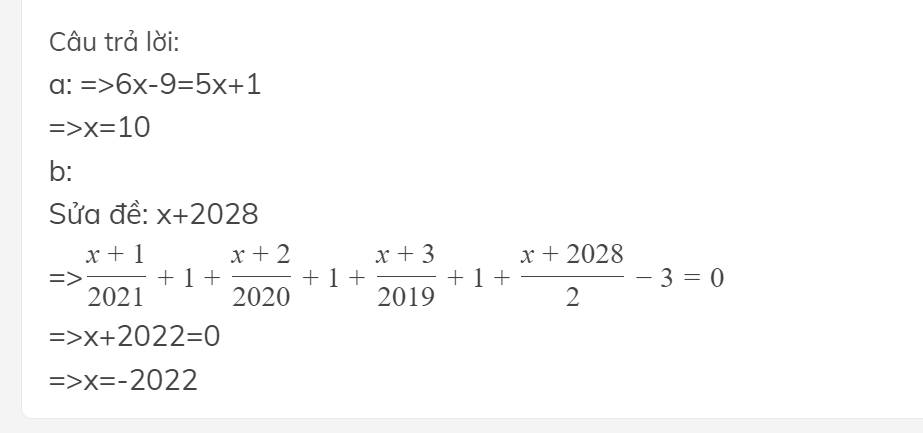Tìm x biết ( x -2020)^x+1-(x-2020)^x+11=0
Hãy nhập câu hỏi của bạn vào đây, nếu là tài khoản VIP, bạn sẽ được ưu tiên trả lời.



|x+19|+|x+5|+|x+2020|=5x(*)
+)Ta có:|x+19|\(\ge\)0;|x+5|\(\ge\)0;|x+2020|\(\ge\)0
=>VT(*)=|x+19|+|x+5|+|x+2020|\(\ge\)0
Mà |x+19|+|x+5|+|x+2020|=5x
=>5x\(\ge\)0
=>x\(\ge\)0
+)Ta lại có:x\(\ge\)0=>x+19\(\ge\)19=>|x+19|=x+19
x\(\ge\)0=>x+5\(\ge\)5=>|x+5|=x+5
x\(\ge\)0=>x+2020\(\ge\)2020=>|x+2020|=x+2020
=>VT(*)=x+19+x+5+x+2020=5x
x+x+x+19+5+2020=5x
3x+2044 =5x
2044 =5x-3x
2044 =2x
=> 2x =2044
x =\(\frac{2044}{2}=1022\)\(\in\)Z
Vậy x=1022
Chúc bn học tốt

=>\(\left(\dfrac{x+1}{2021}+1\right)+\left(\dfrac{x+2}{2020}+1\right)+\left(\dfrac{x+3}{2019}+1\right)+\left(\dfrac{x+2028}{2}-3\right)=0\)
=>x+2022=0
=>x=-2022


ĐKXĐ : \(\left\{{}\begin{matrix}x>2019\\y>2020\\z>2021\end{matrix}\right.\)
Đặt \(\sqrt{x-2019}=a,......\)
Ta được PT : \(\dfrac{1-a}{a^2}+\dfrac{1-b}{b^2}+\dfrac{1-c}{c^2}+\dfrac{3}{4}=0\)
\(\Leftrightarrow\dfrac{1}{a^2}-\dfrac{1}{a}+\dfrac{1}{4}+\dfrac{1}{b^2}-\dfrac{1}{b}+\dfrac{1}{4}+\dfrac{1}{c^2}-\dfrac{1}{c}+\dfrac{1}{4}=0\)
\(\Leftrightarrow\left(\dfrac{1}{a}-\dfrac{1}{2}\right)^2+\left(\dfrac{1}{b}-\dfrac{1}{2}\right)^2+\left(\dfrac{1}{c}-\dfrac{1}{2}\right)^2=0\)
- Thấy : \(\left(\dfrac{1}{a}-\dfrac{1}{2}\right)^2\ge0,......\)
\(\Rightarrow\left(\dfrac{1}{a}-\dfrac{1}{2}\right)^2+\left(\dfrac{1}{b}-\dfrac{1}{2}\right)^2+\left(\dfrac{1}{c}-\dfrac{1}{2}\right)^2\ge0\)
- Dấu " = " xảy ra <=> \(\left\{{}\begin{matrix}\dfrac{1}{a}=\dfrac{1}{2}\\\dfrac{1}{b}=\dfrac{1}{2}\\\dfrac{1}{c}=\dfrac{1}{2}\end{matrix}\right.\) \(\Leftrightarrow\left\{{}\begin{matrix}a=2\\b=2\\c=2\end{matrix}\right.\)
- Thay lại a. b. c ta được : \(\left\{{}\begin{matrix}\sqrt{x-2019}=2\\\sqrt{y-2020}=2\\\sqrt{z-2021}=2\end{matrix}\right.\)
\(\Leftrightarrow\left\{{}\begin{matrix}x-2019=4\\y-2020=4\\z-2021=4\end{matrix}\right.\)
\(\Leftrightarrow\left\{{}\begin{matrix}x=2023\\y=2024\\z=2025\end{matrix}\right.\) ( TM )
Vậy ...

Lời giải:
Ta có: $\Delta=(m-3)^2+16>0$ với mọi $m$ nên pt luôn có 2 nghiệm phân biệt $x_1,x_2$ với mọi $m$.
Theo định lý Viet:
$x_1+x_2=m-3$
$x_1x_2=-4$
Có:
$\sqrt{x_1^2+2020}-x_1=\sqrt{x_2^2+2020}+x_2$
$\Leftrightarrow \sqrt{x_1^2+2020}-\sqrt{x_2^2+2020}=x_1+x_2$
$\Leftrightarrow \frac{x_1^2-x_2^2}{\sqrt{x_1^2+2020}+\sqrt{x_2^2+2020}}=x_1+x_2$
$\Leftrightarrow (x_1+x_2)\left[\frac{x_1-x_2}{\sqrt{x_1^2+2020}+\sqrt{x_2^2+2020}}-1\right]=0$
$\Leftrightarrow x_1+x_2=0$ hoặc $x_1-x_2=\sqrt{x_1^2+2020}+\sqrt{x_2^2+2020}$
Với $x_1+x_2=0$
$\Leftrightarrow m-3=0\Leftrightarrow m=3$ (tm)
Với $x_1-x_2=\sqrt{x_1^2+2020}+\sqrt{x_2^2+2020}$
$\Rightarrow (x_1-x_2)^2=(\sqrt{x_1^2+2020}+\sqrt{x_2^2+2020})^2$
$\Leftrightarrow -2x_1x_2=4040+2\sqrt{(x_1^2+2020)(x_2^2+2020)}$
$\Leftrightarrow 8=4040+2\sqrt{(x_1^2+2020)(x_2^2+2020)}$
$\Leftrightarrow \sqrt{(x_1^2+2020)(x_2^2+2020)}=-2016<0$ (vô lý - loại)
Vậy $m=3$

\(\frac{1}{\sqrt{x+1}+\sqrt{x+2}}+\frac{1}{\sqrt{x+2}+\sqrt{x+3}}+...+\frac{1}{\sqrt{x+2019}+\sqrt{x+2020}}=11\)
\(\Leftrightarrow\)\(\frac{\sqrt{x+2}-\sqrt{x+1}}{\left(\sqrt{x+1}+\sqrt{x+2}\right)\left(\sqrt{x+2}-\sqrt{x+1}\right)}+\frac{\sqrt{x+3}-\sqrt{x+2}}{\left(\sqrt{x+2}+\sqrt{x+3}\right)\left(\sqrt{x+3}-\sqrt{x+2}\right)}\)
\(+...+\frac{\sqrt{x+2020}-\sqrt{x+2019}}{\left(\sqrt{x+2019}+\sqrt{x+2020}\right)\left(\sqrt{x+2020}-\sqrt{x+2019}\right)}=11\)
\(\Leftrightarrow\)\(\frac{\sqrt{x+2}-\sqrt{x+1}}{x+2-x-1}+\frac{\sqrt{x+3}-\sqrt{x+2}}{x+3-x-2}+...+\frac{\sqrt{x+2020}-\sqrt{x+2019}}{x+2020-x-2019}=11\)
\(\Leftrightarrow\)\(\sqrt{x+2}-\sqrt{x+1}+\sqrt{x+3}-\sqrt{x+2}+...+\sqrt{x+2020}-\sqrt{x+2019}=11\)
\(\Leftrightarrow\)\(\sqrt{x+2020}-\sqrt{x+1}=11\)
\(\Leftrightarrow\)\(\sqrt{x+2020}=11+\sqrt{x+1}\)
\(\Leftrightarrow\)\(x+2020=121+22\sqrt{x+1}+x+1\)
\(\Leftrightarrow\)\(22\sqrt{x+1}=1898\)
\(\Leftrightarrow\)\(\sqrt{x+1}=\frac{949}{11}\)
\(\Leftrightarrow\)\(\orbr{\begin{cases}x+1=\frac{900601}{121}\\x+1=\frac{-900601}{121}\end{cases}}\Leftrightarrow\orbr{\begin{cases}x=\frac{900480}{121}\\x=\frac{-900722}{121}\end{cases}}\)
Chúc bạn học tốt ~
PS : sai thì thui nhá

a) \(3\left(2x-x\right)=5x+1\)
\(\Leftrightarrow6x-3x=5x+1\)
\(\Leftrightarrow6x-3x-5x=1\)
\(\Leftrightarrow-2x=1\)
\(\Leftrightarrow x=\dfrac{1}{-2}=-\dfrac{1}{2}\)
b) \(\dfrac{x+1}{2021}+\dfrac{x+2}{2020}+\dfrac{x+3}{2019}+\dfrac{x+4}{2018}=0\)
\(\Leftrightarrow\dfrac{x+1}{2021}+1+\dfrac{x+2}{2020}+1=\dfrac{x+3}{2019}+1+\dfrac{x+4}{2018}+1\)
\(\Leftrightarrow\dfrac{x+2022}{2021}+\dfrac{x+2022}{2020}=\dfrac{x+2022}{2019}+\dfrac{x+2022}{2018}\)
\(\Leftrightarrow\left(x+2022\right)\left(\dfrac{1}{2021}+\dfrac{1}{2020}+\dfrac{1}{2019}+\dfrac{1}{2018}\right)\)
\(\Leftrightarrow x+2022=0\)
\(\Leftrightarrow x=-2022\)

Ta có: \(\left(x-2020\right)^{x+1}-\left(x-2020\right)^{x+11}=0\)
=>\(\left(x-2020\right)^{x+11}-\left(x-2020\right)^{x+1}=0\)
=>\(\left(x-2020\right)^{x+1}\left[\left(x-2020\right)^{10}-1\right]=0\)
=>\(\left[{}\begin{matrix}x-2020=0\\\left(x-2020\right)^{10}=1\end{matrix}\right.\)
=>\(\left[{}\begin{matrix}x-2020=0\\x-2020=-1\\x-2020=1\end{matrix}\right.\)
=>\(\left[{}\begin{matrix}x=2020\\x=2019\\x=2021\end{matrix}\right.\)